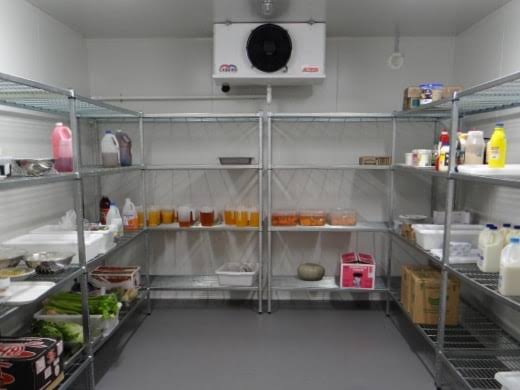A refrigeration cold room is a walk-in cooler or walk-in freezer that is used to store perishable items at a temperature below freezing. Cold rooms are usually found in commercial or industrial kitchens, grocery stores, restaurants, and other food-service businesses. They are also used in laboratories, hospitals, mortuaries, dairies, and other places where perishable items need to be stored at a constant temperature. Refrigeration cold rooms are insulated rooms that have a refrigeration system that maintains the temperature at a constant level. The walls, ceiling, and floor of the cold room are insulated to keep theCold rooms are usually built with smooth, durable, and easy-to-clean surfaces such as stainless steel, aluminum, or tile. The doors of the cold room are also insulated and equipped with weatherstripping to seal out the cold air.
1. Industrial refrigeration is a process in which heat is removed from a space or material, typically for the purpose of preserving perishable food or extending the shelf-life of products. 2. Cold rooms are rooms with controlled temperatures and humidity, used for storing perishable items such as food, pharmaceuticals, and flowers. 3. The three most common types of cold rooms are walk-in coolers, display coolers, and blast freezers. 4. Industrial refrigeration systems can be either direct expansion (DX) or remote condensing (RC). 5. The main components of an industrial refrigeration system are the compressor, evaporator, and condenser.
1. Industrial refrigeration is a process in which heat is removed from a space or material, typically for the purpose of preserving perishable food or extending the shelf-life of products.
Industrial refrigeration is a process in which heat is removed from a space or material, typically for the purpose of preserving perishable food or extending the shelf-life of products. In order for industrial refrigeration to work, a refrigerant is used to absorb heat from the space or material that is being cooled. The refrigerant is then compressed, which raises its temperature. The hot refrigerant is then passed through a coil or series of coils, where it releases its heat. The cooled refrigerant is then expanded, which lowers its temperature. The cycle then repeats itself. Industrial refrigeration systems can be used for a variety of applications, including food storage, pharmaceuticals, chemicals, and more. Cold rooms are a type of industrial refrigeration system that is commonly used for food storage. Cold rooms are typically large, well-insulated spaces that are kept at a very low temperature. Items that are typically stored in cold rooms include meat, dairy products, fish, and vegetables. There are a few things to keep in mind if you are considering using a cold room for food storage. First, you will need to make sure that the room is large enough to accommodate all of the food that you want to store. Second, you will need to make sure that the room is well-insulated in order to keep the cold air in and the warm air out. Third, you will need to make sure that the room has a reliable cooling system. Industrial refrigeration systems are complex and should be installed by a professional. Once you have a cold room set up, you will need to make sure that it is properly maintained. The room should be kept clean and free of debris. The temperature should be monitored regularly and kept at a constant level. The door to the cold room should be kept closed as much as possible to prevent warm air from entering. And finally, the humidity levels in the room should be monitored to prevent condensation and mold growth. By following these simple tips, you can ensure that your cold room is an effective storage solution for your business.
2. Cold rooms are rooms with controlled temperatures and humidity, used for storing perishable items such as food, pharmaceuticals, and flowers.
A cold room is a room with controlled temperatures and humidity, used for storing perishable items such as food, pharmaceuticals, and flowers. Cold rooms keep these items fresh and free from spoilage by inhibiting the growth of bacteria and other microorganisms. Cold rooms are typically found in restaurants, grocery stores, and other commercial establishments where perishable items are sold. They are also used in food processing and preparation facilities, as well as in floral shops. The temperature of a cold room is typically between 32-40 degrees Fahrenheit (0-4 degrees Celsius). The humidity is controlled to prevent condensation, which can cause spoilage. There are several things to consider when designing a cold room, such as the size of the room, the type of cooling system to be used, the type of insulation, and the type of doors and windows. The size of the room will be determined by the amount of space required to store the perishable items. The type of cooling system will be determined by the climate and the efficiency desired. The type of insulation will be based on the intended use of the room and the climate. The type of doors and windows will be based on the type of cooling system and the climate. When designing a cold room, it is important to consult with experts to ensure that the room will meet the needs of the intended use.
3. The three most common types of cold rooms are walk-in coolers, display coolers, and blast freezers.
Walk-in coolers are typically large rooms with cool temperatures used to store perishable items. Display coolers are smaller units that are used to showcase food and drinks. Blast freezers are large units that are used to rapidly freeze items. All three types of cold rooms use refrigeration to keep items cool. Walk-in coolers are the most common type of cold room. They are typically used to store perishable items, such as food and drinks.Display coolers are smaller units that are used to showcase food and drinks. They are often used in convenience stores and supermarkets. Blast freezers are large units that are used to rapidly freeze items.
4. Industrial refrigeration systems can be either direct expansion (DX) or remote condensing (RC).
There are two main types of industrial refrigeration systems: direct expansion (DX) and remote condensing (RC). DX systems are popular because they are simple and efficient. In a DX system, refrigerant is piped directly to the refrigeration units, where it expands and cools the air. RC systems are more complex, but they offer some advantages over DX systems. In an RC system, the refrigerant is first condensed in a central unit, then pumped to the refrigeration units. This allows the units to be smaller and more efficient.
5. The main components of an industrial refrigeration system are the compressor, evaporator, and condenser.
The main components of an industrial refrigeration system are the compressor, evaporator, and condenser. The compressor circulates refrigerant through the system and pressurizes it so that it can evaporate at a lower temperature. The evaporator removes heat from the air or liquid being cooled and turns the refrigerant into a vapor. The condenser cools the refrigerant vapor and turns it back into a liquid.
A cold room is a highly useful tool for businesses that need to store large quantities of food and other perishables. By understanding how a cold room works and what its key features are, you can ensure that your business can make the most of this valuable storage space.


